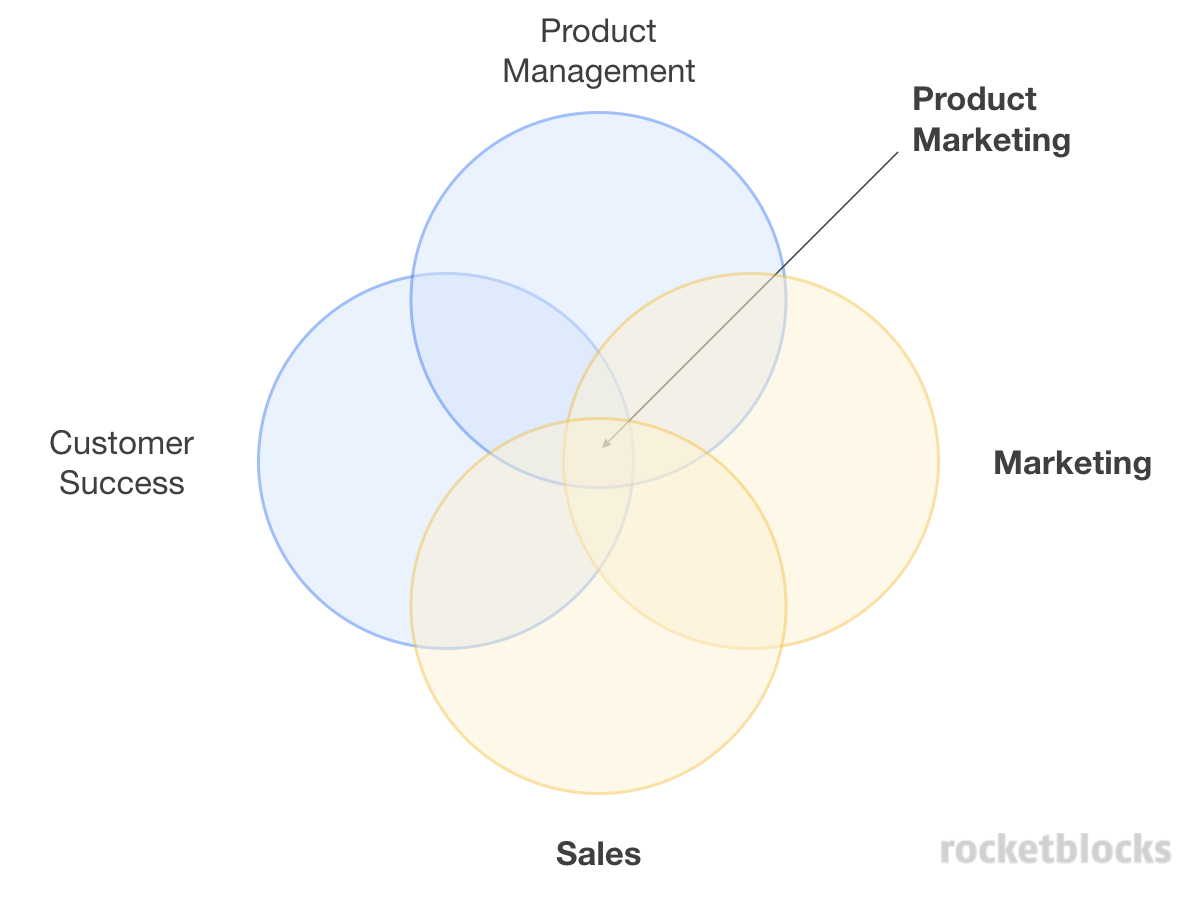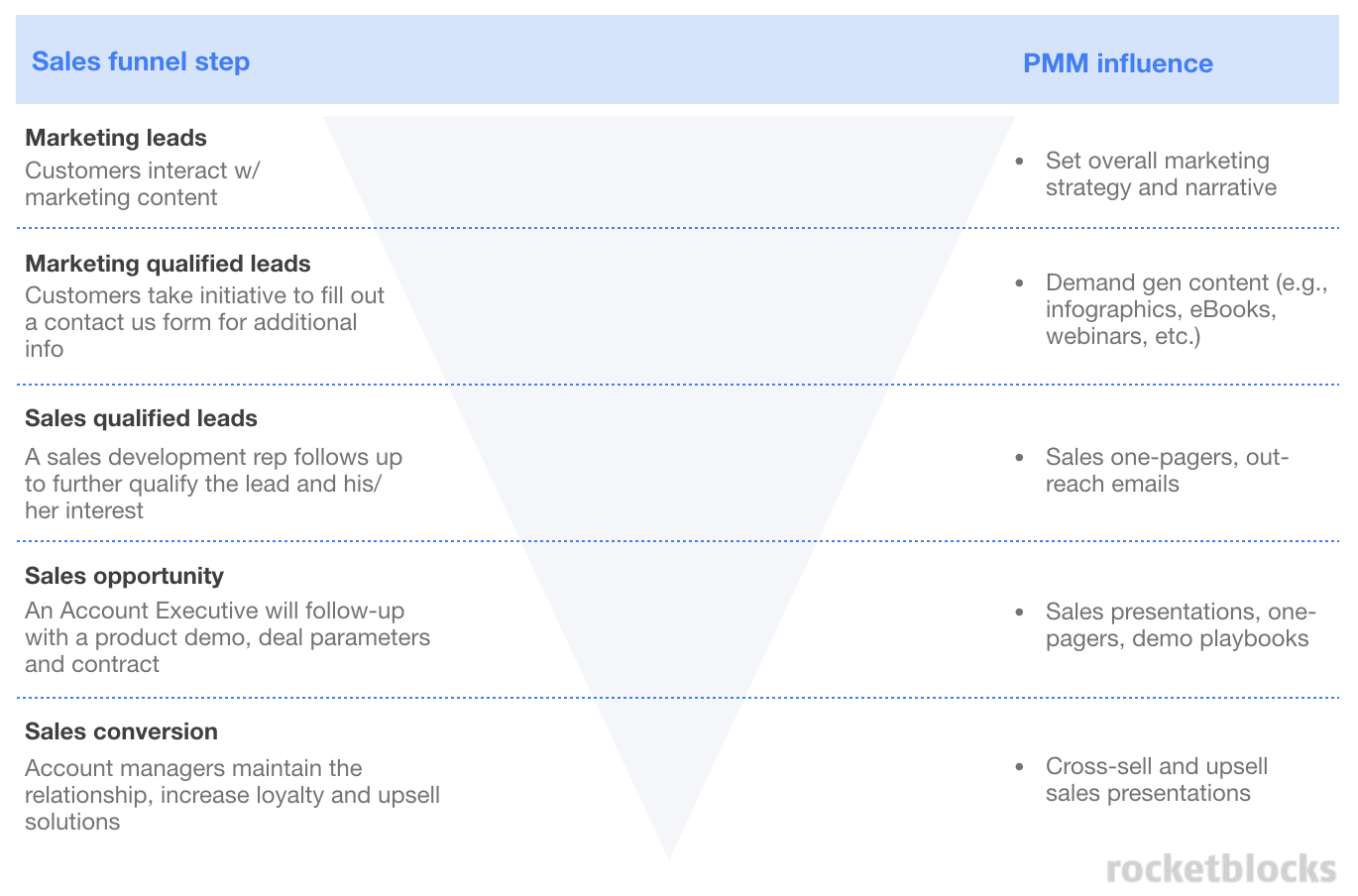PMM and sales & marketing team collaboration
An overview of how to best partner with sales, sales ops and extended marketing teams to drive adoption
|
|
|
Product, product marketing, sales and marketing are all working towards the same goals: raise awareness, drive product adoption and secure business opportunities to help their company grow.

We talked about how to work with product in the previous section. In this article, we will introduce the different marketing and sales stakeholders and how to strategically partner with both teams. We will start with Marketing and then cover sales (you can skip the sales section if you are applying for a B2C PMM role).
Working with the marketing team
Marketing is dynamic and impactful. Their job is to drive awareness, promote a business, product, or service. PMM's success in modern technology companies means they are able to understand and collaborate closely with very specialized marketing colleagues.
Marketing has existed since the late 1800's with the invention of the first mail product catalogue. Tiffany's Blue Book was the first mail-order catalogue in the United States that really set the standard for product-driven marketing. For the longest time, the evolution of Marketing has been slow and steady with very few innovations. However, with the invention of the internet and mobile phones, marketing has has evolved more in the last 20 years then its previous 200 years combined.
This evolution also helped transform Marketing organizations centered around generic marketing manager roles to a hyper-specialized team of marketers. To create a strategy and an impactful marketing plan, PMMs need to know how to leverage each marketing function.
Product marketing. Owns the GTM strategy and are the marketing campaign architects. They leverage insights to develop a product narrative, segment the market and coordinate an integrated multi-channel marketing strategy.
Brand marketing. Owns the strategy, voice and narrative for the business brand. Their goal is to drive business volume by increasing the company's brand equity & reputation.
Creative marketing: Owns art direction, tone of voice, visual guidelines and campaign creative headlines and taglines. They bring concepts to life.
CRM: Owns lifecycle communication to the existing and prospective contact lists. They can deploy comms through owned channels, such as email and in-app messaging.
Performance marketing: Owns paid media strategy and deployment. They deploy search and social ads and optimize SEO strategies.
Web marketing: Owns web content strategy and conversion. They create web content, design web infrastructure for optimal performance, measure traffic and engagement.
Content marketing: Owns customer content. Mostly relevant for B2B orgs, they create content to drive marketing leads, educate customers and promote thought leadership. They create content that is gated, meaning, to access this content, users need to provide their contact information (e.g., eBooks, whitepapers, case studies).
PR & media: Owns earned channels, such as media relations. They write press releases, brief the press and manage media & industry analysts.
Regional marketing: Owns regional growth strategies. They generate sales leads through demand generation campaigns and account based marketing tactics.
As a product marketing manager, you will partner with each marketing team to build a comprehensive, multi-channel integrated marketing plan. A PMM's marketing brief is the source of truth for all tactics and initiatives identified in the marketing plan. PMMs will create the strategy and marketing brief designed to inspire the other marketing functions to produce creative work and execute on the plan.
A great brief not only inspires work but can ultimately move cultures, brands, people. A great brief is a combination of: a problem + an insight + an idea. When PMMs write marketing briefs, they need "prison yard clarity". This means nothing in the brief can be misunderstood or it would be "extremely dangerous" for the plan, timeline and work. To get the best out of other marketing teams, PMMs need to be as clear and unambiguous as possible in their briefs.
Here's a couple of well known marketing creative briefs: RedBull and Reebok.
Once the brief is created and approved, PMMs will act as program managers, creating weekly status meetings, keeping a timeline, managing the launch calendar and reporting on the progress of each tactic and initiative. Please note, that at smaller companies, PMMs may need to wear different hats and perform some of the work identified above.
Working with the sales team
For B2B organizations, education and relationship building is critical in order to be successful. The vast majority of B2B companies rely on having a sales team to drive customer acquisition. PMM and Sales teams must work closely together and focus their actions on identifying the different types of decision makers at organizations and their problems and opportunities. Product Marketing needs to provide Sales with the right insights, narratives and high quality, relevant, content to help them demo and navigate conversations for a shot at converting an opportunity into a deal and ultimately a long-term relationship.
And just like Marketing, the emergence of new technologies and market dynamics have evolved sales organizations from general sales managers to more specialized sales functions.
Business Development Representatives (BDRs). They are in charge of bringing new business opportunities, usually through cold email, cold calls, networking, and social selling through LinkedIn and other social sites.
Account Executives (AEs). They are in charge of following up on qualified leads generated by Marketing or BDRs, and building demo strategies to close deals. AEs are also known as sales managers.
Sales Operations (Ops) : They are in charge of lead routing & maintenance, contact list management and sales incentive strategies. They ensure leads are being pursued by AEs.
Account Managers (AMs): They are in charge of managing high-volume, important key business accounts. Their goals are to retain existing clients and drive strategies to upsell and/or cross-sell other business products.
Sales Enablement: They are in charge of educating and empowering BDRs, AEs and AMs to efficiently communicate value to clients and prospects.
PMMs play a critical role in ensuring the sales organization is trained, empowered, has a healthy lead pipeline and the right tools to close deals, upsell and cross sell. A PMM's work can be seen across the entire sales pipeline. I created the graphic below to illustrate the role of PMM across the entire sales funnel.

The only way for Product Marketing to gain credibility and drive impactful work is to know how Sales and Marketing teams are structured, how their roles are defined and what their goals are. Equipped with this information, PMMs can design breakthrough strategies and manage multi-channel creative marketing plans.
P.S. Are you preparing for PMM interviews?
Real interview questions. Sample answers from PMM leaders at Google, Facebook, Amazon, Uber, PayPal and more. Plus study sheets on key concepts like positioning, GTM & more.




